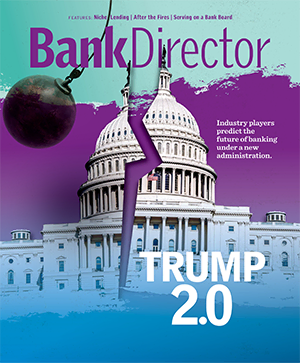J. Scott Petty is a Partner in the Dallas office of Chartwell Partners and leads the firm’s Financial Services Practice serving bank, mortgage, wealth management and real estate clients across the country. Scott has an established 30-year track record advising boards and CEOs on making key leadership decisions for small- and mid-cap public and closely-held private companies. Prior to joining Chartwell in 2009, Scott spent over a decade between his tenures with Heidrick & Struggles and Spencer Stuart. Over the course of his time with each firm, he led search practices in banking, real estate, and broad financial services. Scott is a graduate of The University of Texas at Austin with a bachelor’s degree in psychology and minor in business management.

The Tough Choice Between Internal Promotions or External Hiring
Firms that strike a balance between developing internal talent and hiring externally can build strong, adaptable leadership teams.
Brought to you by Chartwell Partners

Whether to promote a current employee or hire an external candidate is a long-standing discussion in talent management, especially in financial services, where expertise, leadership and adaptability are critical. Some firms look externally for fresh perspectives while others look to focus on internal promotions to ensure cultural continuity. The best strategies often combine internal development with external strategic hires.
Bank Director’s 2024 Compensation and Talent Survey revealed that 75% of banks plan to look externally to address gaps in their talent pipeline, and 70% also have an interest in enhancing internal talent development efforts to prepare current leaders for the future.
Here’s an overview of both approaches, their pros and cons, and how companies are balancing the two.
Internal Talent Development
Internal talent development entails investing in existing employees by training, mentoring and preparing them for leadership roles.
Pros:
- Cost efficiency. Internal promotions often cost less than external hires, who may demand higher salaries and take time to onboard.
- Cultural fit. Employees already understand the company’s culture, values, and operations.
- Higher retention and loyalty. Employees are more likely to stay if they see growth opportunities within the company.
- Faster productivity. Promoted employees already know the business and can transition smoothly into their new roles.
Cons:
- Limited perspectives. Relying solely on internal promotions can lead to stagnation and a lack of new ideas.
- Skill gaps. Some specialized or high-level roles may require expertise that current employees don’t yet possess.
- Potential biases. Promoting from within can reinforce internal hierarchies and limit diversity.
As you evaluate your talent pipeline, it may make sense for you to choose internal development when you already have strong leadership development programs in place, when maintaining company culture and institutional knowledge is a priority or when long-term succession planning is a focus.
External Hiring
Recruiting leaders or specialists from outside your institution can bring fresh ideas, expertise and skills.
Pros:
- Fresh perspectives and innovation. External hires bring different experiences, industry knowledge and new ideas.
- Filling skill gaps quickly. External candidates often have specialized expertise that may not exist internally.
- Competitive advantage. Hiring top talent from competitors can strengthen your market position.
Cons:
- Higher costs. Recruiting, onboarding and offering competitive salaries can be expensive.
- Longer adjustment period. New hires need time to understand company processes and build relationships.
- Cultural misalignment. External hires may struggle to fit into the company culture or team dynamics.
Your company could benefit the most from external hiring when you need a rapid skill infusion in a critical area, your bank needs critical expertise that is lacking, innovation or transformation is a key goal or there is no clear internal successor for a leadership position.
Balancing Both Approaches
Many financial institutions take a hybrid approach, blending internal development with selective external hiring. This approach includes:
- Succession planning or identifying high-potential employees for leadership while filling gaps with external hires.
- Leadership development programs that include investing in mentorship, training and rotational programs to prepare internal talent.
- Strategic external hiring to bring in external leaders when a fresh perspective or specialized skill is required.
A lot of companies operate with an 80/20 rule: 80% promoted from inside and 20% external hires to keep fresh ideas, limit group think and bring in expertise that can see around corners. If your institution is ruminating on the idea of an external executive hire, it may be helpful to remember that external hires often pay for themselves many times over and can help scale the company faster.
Final Takeaway
The best approach depends on a company’s strategy, industry trends and specific leadership needs. Firms that find the right balance between developing internal talent while selectively hiring externally tend to build strong, adaptable leadership teams.


